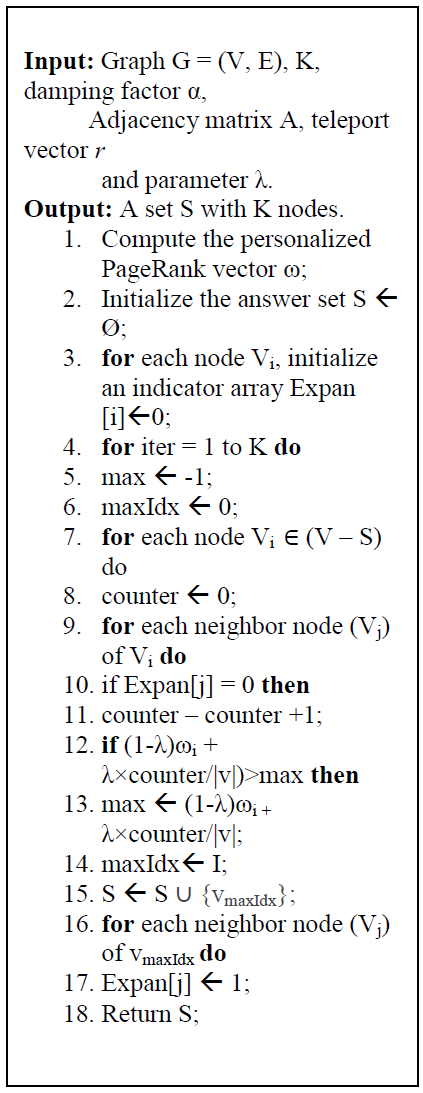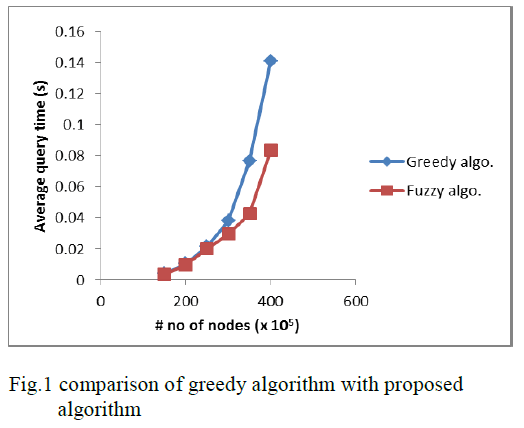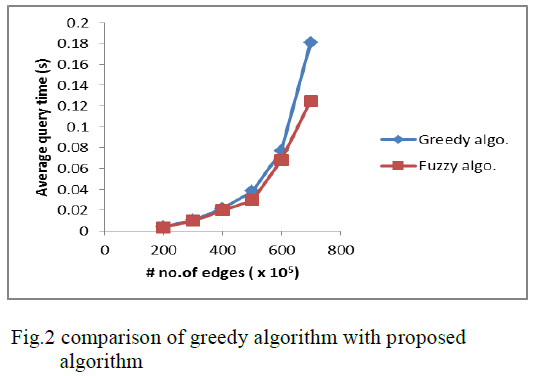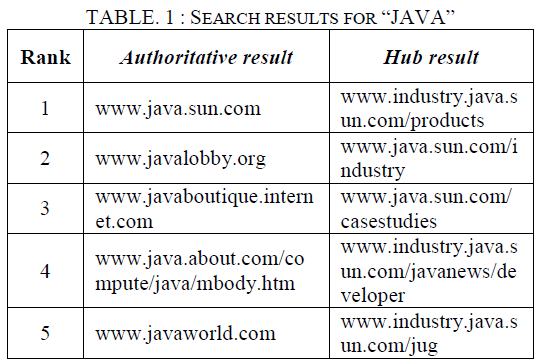The main goal of ranking web pages is to find the interrelated pages. This interrelation of pages is represented as weighted graph. Ranking nodes on graphs is a fundamental task in information retrieval, data mining, and social network analysis. Many existing diversified ranking algorithms either cannot be scalable to large number of nodes due to time and memory requirements or reasonable diversified ranking measure. Graph-based algorithms are stationary distribution of the random walk on the graph. Diversified ranking measure was proposed for large graphs to identify the relevance and diversity among nodes. This measure is a nondecreasing submodular set maximization problem. To solve this problem an efficient greedy algorithm was developed with linear time and memory requirements, and the size of the graph to achieve near-optimal solution. This paper presents a system that provides users with personalized results derived from a search engine that uses link structures. The proposed system uses fuzzy document retrieval (constructed from a fuzzy concept network based on the user’s profile) that personalizes the results returned from link-based search engines with the preferences of the specific users. Experimental results show that the developed method is scalable for large graph with linear time and space complexity and it has considerable efficiency in determining the rank of web pages.
Keywords |
| Diversified ranking, graph algoritms,
Submoduler function, Fuzzy document retrivel |
INTRODUCTION |
| Ranking nodes on a graph is a primary task in
information retrieval, mining task. Webpage [1] ranking in
social networks provides personalized services for web
search [3].Many existing graph-based ranking algorithms
such as PageRank algorithm [3], [4] is a random walk on
graphs. In this approach the node of a graph is ranked |
| higher by considering the more links between the
nodes. The random walk method is used to identify the
top-K ranking list contain many similar nodes by
considering only the relevance of the nodes. It reduces the
ranking effectiveness and diversity is not achieved. To
overcome THIS problem while designing the ranking
algorithms, allowing the diversity in the top-K ranking
list. We propose a novel diversified ranking approach,
using query node the personalized PageRank is calculated
and diversity is identified. The diversity ranking measure
is used to identify the nodes that are not only relevant to
the query but also dissimilar nodes. The diversified
ranking measure is optimized by graph expansion, where
the nodes will have a large expansion then the nodes will
be dissimilar among them and the diversity is obtained.
Thus the proposed novel diversified ranking measure is a
nondecreasing submodular set function. By using the
submodularity of this method an efficient greedy
algorithm is developed with linear time and space
complexity w.r.t the size of the graph. To optimize the
linear time and space complexity a randomized greedy
algorithm is developed by using the generalized
diversified ranking measure by taking the K-step
expansion. |
RELATED WORK |
| A. Incremental diversification for very large sets: a
streaming -based approach |
| A given user query often has a variety of intended
meanings or associated information needs. Most existing
approaches use approximation techniques and heuristics
to increase the efficiency of diversification but cannot be
applied for diversification of result streams.
Diversification of results is impossible for systems that
potentially process thousands of queries in parallel when
they use algorithms with super-linear runtime and linear
memory requirements. To solve problem using a
streaming-based approach which processes items
incrementally, maintaining a near-optimal diverse set at any point in time. This approach has linear computation
and constant memory complexity with respect to input set
size, and naturally fits for streaming applications. New
incremental approach is linear in computational
complexity and constant in memory complexity w.r.t the
number of items, and therefore also very well suited for
very large sets. In addition, our streaming-based
computation enables very efficient diversification of
queries over continuous data sources such as news
streams or tweets, opening up further applications of
diversification. |
| B. Diversity in ranking via resistive graph center |
| In this approach the formulation of diversity as finding
centers in resistive graphs. Unlike in PageRank, we do not
specify the edge resistances and ask for node visit rates.
Instead of that identify the sparse set of center nodes so
that the effective conductance from the center to the rest of
the graph has maximum entropy. In marked deviation from
prior work, our edge resistances are learnt from training
data. Inference and learning are NP-hard, but we give
practical solutions. The Markov walk approach can
potentially get around this problem by directly comparing
items without reference to the units of coverage. However,
existing work hardwires edge weights rather than learn
them. Markov walks express associativity a node i with
large score linking to node j pulls up the score of j .
However, diversity demands dissociative decisions: if i
and j are both relevant and very similar, we should pick
only one of them. |
| C. Diversified ranking on large graph :An optimation
view point |
| A good top-k ranking list should identify both the
relevance and the diversity. But this method does not
exist, such a goodness measure for the graph data in the
literature. Most of the existing works for diversified
ranking on graphs are based on some heuristics. To find
an optimal, or near-optimal, top-k ranking list that
maximizes the goodness measure. Bringing diversity into
the design objective implies that we need to optimize on
the set level. It is usually very hard to perform such setlevel
optimization. we address these challenges from an
optimization point of view. We propose a goodness
measure which intuitively captures both (a) the relevance
between each individual node in the ranking list and the
query node; and (b) the diversity among different nodes in
the ranking list. We further propose a scalable algorithm
that generates a provably near-optimal top-k ranking list.
To the best of our knowledge, this is the first work for
diversified ranking on large graphs that has a clear
optimization formulation and finds a provably near
optimal solution, and enjoys the linearly scalability. |
| D. DivRank: the interplay of prestige and diversity in
information networks |
| Many retrieval and mining tasks are concerned with
finding the most important and/or relevant items from a
large collection of data. These measures are known as
centrality (or prestige) measures in general, with various
instantiations like degree, closeness, between nodes, and
more complicated measures such as the PageRank score
and the authority score. These measures can be also
combined with other features such as the relevance to a
query. The diversity in top ranked results has been recognized as another crucial criterion in ranking. The
need of diversity in ranking is even more urgent when the
space of output is limited. The proposed system has a
novel ranking algorithm, DivRank, based on a reinforced
random walk in an information network. This model
automatically balances the prestige and the diversity of
the top ranked vertices in a principled way. DivRank not
only has a clear optimization explanation, but also well
connects to classical models in mathematics and network
science. |
DIVERSIFIED RANKING METHODOLOGY |
| A. Personalized PageRank Algorithm |
| Personalized PageRank [1] is a query dependent
ranking algorithm. Given a query vector r, a graph G the
personalized PageRank vector ω is calculated for each
iteration using an equation: |
 |
| Where α is a damping factor and A is the adjacency
matrix of graph G. The PageRank vector ω is used to rank
the nodes of the graph. |
| Stationary distribution of random walks is used by
personalized PageRank for ranking the nodes in a graph
instead of diversity. Markov chain [11] is formed by the
random walk on graph, If a node gets hit frequently by
random walks then that node is considered as high
personalized PageRank score, thus the neighbors of that
node also gets hit frequently and taken as high
personalized PageRank score where the top-K ranking list
contains many similar nodes and the personalized
PageRank algorithm results in reducing the effectiveness
of ranking among the nodes, so diversity must be
provided for the application. |
| B. Diversified Ranking Problem |
| To improve diversity there are many ranking
algorithms on graphs [5], [6], [7] but the algorithms
cannot scale to large scale graphs or provide an effective
ranking measure. |
 |
| Fig 1. Illustration of our idea: expansion ratio versus
diversity. Red square nodes denote the selected nodes and
green nodes are expanded nodes. |
| We propose a scalable diversified ranking algorithm to
optimize the ranking process accurately. The diversified
ranking problem is formulated as: |
| Notations and definition. Consider a graph G = (V , E),
with a set of nodes V and a set of edges E, where the size
of nodes is n = |V|. |
| Definition: Let S be a set of nodes. The expanded set of
S is denoted by |
 |
The expansion is of a set of nodes, S, is the size of
expanded set, N(S), denoted as |N(S)|. And the expansion
ratio is defined as  |
| Expansion of a graph is based upon the directed and
undirected topological structure. Expansion of expander
graph is different from the expansion which is equal to the
minimum expansion ratio among all expanded sets. The
nodes are dissimilar to each other and they do not have any
common neighbors in a graph since they have a large
expansion ratio, so it is well known that better diversity is
achieved in the set of nodes with large expansion ratio.
Consider we take three nodes from Fig 1(b) and 1(c). In fig
1(b) the nodes are well connected and they have similar
nodes while in Fig1(c) the nodes have no edge connected
between them so they have dissimilar nodes, from the
above figure it is clear that Fig1(c) is more diverse than
Fig1(b) since Fig 1(c) has large expansion ratio. |
| In a graph a node must have high personalized
PageRank and be dissimilar to the selected nodes.
Diversified ranking measure is achieved by combining
relevance and diversity which is called as maximum
marginal relevance (MMR). A document which is used by
MMR is relevant to the query and dissimilar in other
words the document has high marginal relevance. To find
a subset S of K nodes such as the nodes S with high
personalized PageRank scores and expansion ratio of
|N/S|/n is maximum. Our aim is to maximize the
diversified ranking measure which is formulated below: |
 |
| w denotes the personalized PageRank scores of node u,
and λ ∈ [0,1] is a parameter used to trade off the relevance
and diversity. In (2) the first term is the personalized
PageRank scores which is based on relevance and second
term is the expansion ratio of ranking results. It is known
that the system will focus on top-K ranking list but F(S)
does not produce the accurate ordering of top-K ranks so
we propose an algorithm for ordering the ranking list
based upon combining the relevance and diversity scores. |
| C. Diversified Ranking Algorithm |
| Many algorithms are developed to overcome the
diversified ranking problem such as NP hard. From the
definition given below it is clear that the diversified
ranking measure (F(S)) is a nondecreasing submodular set
function. Using (F(S)) a near-optimal greedy algorithm is
developed to overcome the ranking problem efficiently. |
| Definition: Let V be a finite set, a real valued function
f(S) on the set of subsets of V, S, is called a nondecreasing
submodular set function, if the following conditions hold. |
| Nondecreasing. For any subsets S and T of V
such that S⊆T⊆V, we have f(S) ≤ F(T). |
| Submodularity. Let ρj(S) = (S ∪ {j}) – f(S) be
marginal gain. Then, for any subsets s and t of v such that S⊆T⊆V and j ∈ V\T, we have ρj(S) ≥
ρj(T). |
| Greedy Algorithm: |
 |
| In this greedy algorithm, First the personalized PageRank
vector is identified by measuring the relevance of nodes.
Then for each iteration a node with maximum mariginal
gain is chosen and added to the answer set S. The iteration
is repeated for K times and as a result ordering ranking
list is produced based on ρu(S) which satisfies the
nondecreasing properties and node with top-K ranking
score appers in top-K ranking list. |
| Complexity analysis of the greedy algorithm. The time
complexity of algorithm is O(K|E|). Since the algorithm
must visit all the nodes and its neighbors in the system
which takes 2|E| time in worse case, so CELF framework
is used to speed up the process and for space complexity
is O(|V|+|E|) all the parameters such as input, output,
personalized PageRank, answer set and array are put
together and it is scalable for large scale graphs. |
| D. Generalized diversified ranking |
| F(S) considers only immediate nodes in set of nodes
S. To generalize this diversified ranking measure F(S) by
taking |
| k-step nearest nodes into rank, its denoted by Fk (S) using
k-step expanded set. |
 |
Ranking algorithm using fuzzy concept: |
| We propose a system that searches web documents
based on link information and fuzzy concept network.
This method calculates the relevance of nodes using fuzzy
logic with user profile. The search engine is able to select
fitting websites for the user’s query by processing fuzzy
document retrieval system using the fuzzy concept
network to represent the user’s knowledge. The
motivation of this research is to find a user profile to link
based search engines. The fuzzy concept network
provides the inference mechanism to calculate undefined
relationships between concepts. Undefined information
can be calculated using a transitive closure of the fuzzy
concept matrix. This property can minimize the user’s
cognitive load to insert the relevance of concepts. This
approach suffers from the inconvenience of obtaining
information from the user, it can be improved by the use
of a fuzzy concept network and various ranking algorithm
were used such as, |
| Personalized PageRank (PPR) algorithm which is
used to evaluate the relevance of the nodes. |
| Grasshopper (Gra) algorithm is used to achieve the
diversity. |
| Manifold ranking with stop points (MRSP) is similar
to Grasshopper algorithm used in graphs. |
| DivRank (Div R), this algorithm is used to achieve
similar ranking performance using two various
implementation such as pointwise DivR and
cumulative DivR. |
| Dragon (Dra) algorithm is used to optimize the
diversified ranking measure but lacks topological
explanation. |
| Diversified ranking via resistive graph centers (RGC)
algorithm tries to achieve diversity in ranking but
cannot be scaled in large graphs. |
| Ranking algorithm using fuzzy concept provides high
quality results and retrieval of document is faster while
searching process of related documents are efficient.
Users will be provided with accurate information by using
fuzzy concept network. |
EXPERIMENTAL RESULTS |
| The personalized search engine selected the five most
authoritative results as a source of personalization and
produced a document descriptor of these documents. The
ranking of these five documents was reordered with
respect to the user’s interest recorded on a user profile. A
fuzzy concept network for a user was generated based on
20 degrees of relevance in the user profile, and
unrecorded information was inferred from the transitive
closure of the fuzzy concept network. The expanded
document descriptor resulted from the multiplication of
the document descriptor and the user’s fuzzy concept
network. The sum of the degree of relevance with respect
to the concepts determined the new ranking of the
documents as the final result. |
 |
 |
 |
CONCLUSION |
| To finding top-K diversified ranking on graphs using a
novel diversified ranking measure, which captures both
relevance and diversity. We prove the sub modularity of
this measure and design an efficient greedy algorithm to
achieve near-optimal diversified ranking. The proposed
method has linear time and space complexity w.r.t. the
size of the graph, thus it can be scalable to large graphs.
We present a generalized diversified ranking measure and
the proposed system uses fuzzy document retrieval
(constructed from a fuzzy concept network based on the
user’s profile) that personalizes the results returned from
link-based search engines with the preferences of the
specific users. The developed method is scalable for large
graph with linear time and space complexity and it has
considerable efficiency in determining the rank of web
pages. |
FUTURE ENHANCEMENT |
| Ranking nodes on graphs is a fundamental task in
information retrieval and data mining task. . Diversified
ranking measure was proposed for large graphs to identify
the relevance and diversity among nodes with linear time
and space complexity. To find relevant web documents
for a given user, the proposed search engine uses link
structures and a fuzzy concept network. For efficient
searching, these link structures are stored in advance. The
fuzzy document retrieval system personalizes the linkbased
search results with respect to the user’s interests
and reorders the ranking results. Future work will proceed
as follows. Using the user’s feedback about the search
results, it is possible to change the value of the fuzzy
concept network. This adaptation procedure helps to
obtain better results. These preliminary results indicate
that a soft computing method such as fuzzy logic can play
a crucial role in information retrieval from the web, which
provides an important platform for personalization of
search engines. |
References |
- C.L.A. Clarke, M. Kolla, G.V. Cormack, O. Vechtomova, A.Ashkan, S. Buttcher, and I. MacKinnon, “Novelty and Diversity inInformation Retrieval Evaluation”, Proceedings of 31st AnnualInternational ACM SIGIR Conference on Research andDevelopment in Information Retrieval (SIGIR ’08), pp. 659 – 666,2008.
- A.Dubey, S.Chakrabarti, and C.Bhattacharyya, “Diversity inRanking via Resistive Graph Centers” Proceedings of 17th ACMSIGKDD International Conference on Knowledge Discovery andData Mining (KDD), pp. 78-86, 2011.
- M.Drosou and E.Pitoura, “Search Result Diversification”, ACMSIGMOD Record, vol. 39, pp. 41-47, 2010.
- S.Gollapudi and A.Sharma, “An Axiomatic Approach for ResultDiversification” Proceedings of 18th International Conference onWorld Wide Web (WWW ’09), pp. 381 – 390, 2009.
- R.H.Li and J.X. Yu, “Scalable Diversified Ranking on LargeGraphs”, Proceedings of IEEE 11th International Conference onData Mining (ICDM), pp. 1152-1157, 2011.
- Q.Mei, J.Guo, D.R.Radev, “DivRank: The Interplay of Prestigeand Diversity in Information Networks”, Proceedings of 16th ACMSIGKDD International Conference on Knowledge Discovery andData Mining (KDD ’10), pp. 1009 – 1018, 2010.
- E. Minack, W. Siberski, and W. Nejdl, “IncrementalDiversification for Very Large Sets: A Streaming-BasedApproach”, Proceedings 34th International ACM SIGIRConference on Research and Development in InformationRetrieval (SIGIR), pp. 585-594, 2011.
- H.Tong, J.He, Z.Wen, R.Konuru, C.Y.Lin, “Diversified Rankingon Large Graphs: An Optimization Viewpoint”, Proceedings of17th ACM SIGKDD International Conference on KnowledgeDiscovery and Data Mining (KDD), pp. 1028 – 1036, 2011.
- X.Zhu, A.B.Goldberg, J.V.Gael, D.Andrzejewski, “ImprovingDiversity in Ranking Using Absorbing Random Walks”Proceedings of Human Language Technologies: The AnnualConference, North America,pp. 97 – 104, 2007
- X.Zhu, J.Guo, X.Cheng, P.Du, and H.Shen, “A UnifiedFramework for Recommending Diverse and Relevant Queries”Proceedings of 20th International Conference on World Wide Web(WWW ’11), pp. 37 – 46, 2011
- S.Brain and L.Page,”PageRank: Bringing Order to theWeb”,technical report, stanford digital Library Project,1997.
- M.E.J. Newman, Networks: An introduction. Oxford Univ. Press,2010.
- O.Haggstrom, Finite Markov chains and Algorithmic Applications.Cambridge Univ. Press,2002..
- H.Ma,M.R. Lyu, and I.King, “Diversifying Query SuggestionResults’, Proceedings International conference in artificalintelligence,2010.[15] P.Flajolet and G.N Martin,”Probilistic Counting Algorithms forData Base Applications”,J.ComputerSysyem Science, volume31,no.2,PP.182-209,1985.
|